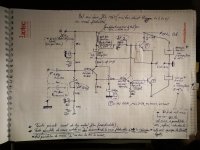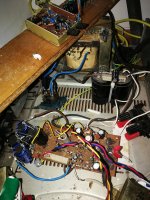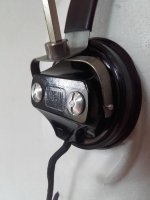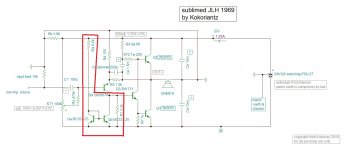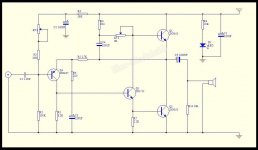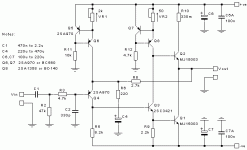Hi Huggy,
I found that original ST microelectronics (ex SGS Thomson) transistors BD's and 2N's and some other 2STA to sound very good. I think that your ST's were fake... 🙂
I found that original ST microelectronics (ex SGS Thomson) transistors BD's and 2N's and some other 2STA to sound very good. I think that your ST's were fake... 🙂
Hi,
Because of the limited time that i have latelly i didnt manage to post my sublimmed JLH.
From respect to Kokorianz i will post it here because it works pretty darn well and its derived from his version and works like charm directly on veroboard with parts that i had from the monkey box 😎..
I had the original JLH69 with cap coupling and was very satisfied with it until i found the sublimmed JLH. It is indeed an update at each chapter (bass, treble,mids, clearance and very good separation of each instrument). This is, for now, a very very good amplifier and i have the Hiraga 30w too and have to say that this Sublimed Jlh is now there, at the same level, and even better. The Hiraga with 1F filtration and dual mono and allot of exotics in it is abit more fuller in the mids, but in rest the Sublimed has more bass, clarity, feels more dynamic and seems to be more reavealing, woth tons of microdetails. The 1.5 A bias gives a little bit more openes to the overall sound wich i like. The choke is actually a 220/2*12vac unmodified trafo... Overall i will chose the Sublimed Jlh or a JLH69 with exotics at any hour.
Cheers
Sergiu
Because of the limited time that i have latelly i didnt manage to post my sublimmed JLH.
From respect to Kokorianz i will post it here because it works pretty darn well and its derived from his version and works like charm directly on veroboard with parts that i had from the monkey box 😎..
I had the original JLH69 with cap coupling and was very satisfied with it until i found the sublimmed JLH. It is indeed an update at each chapter (bass, treble,mids, clearance and very good separation of each instrument). This is, for now, a very very good amplifier and i have the Hiraga 30w too and have to say that this Sublimed Jlh is now there, at the same level, and even better. The Hiraga with 1F filtration and dual mono and allot of exotics in it is abit more fuller in the mids, but in rest the Sublimed has more bass, clarity, feels more dynamic and seems to be more reavealing, woth tons of microdetails. The 1.5 A bias gives a little bit more openes to the overall sound wich i like. The choke is actually a 220/2*12vac unmodified trafo... Overall i will chose the Sublimed Jlh or a JLH69 with exotics at any hour.
Cheers
Sergiu
Attachments
The big caps can be some Panasonic FC or some cinese industrial 4700uf@105degrees...
The options for the trannies are listed there in order of my preference from top to bottom.
The options for the trannies are listed there in order of my preference from top to bottom.
Just wondering if we could make an equivalent mod on the dual rail version of the JLH... 😕
I used to have built 2 JLH 2005 mono-blocks with 4 output drivers each and really enjoy them since a few years.
I used to have built 2 JLH 2005 mono-blocks with 4 output drivers each and really enjoy them since a few years.
Hi,
...and i have the Hiraga 30w too and have to say that this Sublimed Jlh is now there, at the same level, and even better. The Hiraga with 1F filtration and dual mono and allot of exotics in it is abit more fuller in the mids, but in rest the Sublimed has more bass, clarity, feels more dynamic and seems to be more reavealing, woth tons of microdetails.
Hiraga Classe A?
Which speakers do you use? The Classe A is a 4-stages-complementary-parts-design. It sounds horrible, in the mids too - with or without 1 F-)-;
has this amp enough gain to be connected directly to source like CD player or soudcard?
thanks
I usually drive it with my phone and is more than enough output power. For critical listenings i use an external dac or good old philips swing arm with tda1541 moded cd player and 25k pot on the input of the amp. My speakers have 95dB with a second order filter for each driver (bass+mid-high) so a maximum for me is 4-7w...
I will not argue with anyone on the tematic with whom sounds better than this or that. All i can say is that a piano has to be a piano on high and low notes and the voice of Melody Gardot from the album 'Currency of man' (artist's cut) in flac format must be immaculate, detailed and very present. I was at some of her live concerts and i know what i'm looking for. I usually listen to almost all kinds of music and these things are some of my benches.
Cheers
Hi Sergiu,
Thank you for your inspiring experiments and you tribute to Kokoriantz. In post 53 you mention: ‘I also tried the floating ground’. In that post it was not explained what exactly a floating ground is. In post 82 you have posted a schematic (what the text in it means, I can only guess). The vas of the schematic contains a string of resistors 50K variable + 47k + 39K. Between 47k and 39k a capacitor to ground is added. Is this construction what you mean by ‘floating ground’? Please elaborate.
Thank you for your inspiring experiments and you tribute to Kokoriantz. In post 53 you mention: ‘I also tried the floating ground’. In that post it was not explained what exactly a floating ground is. In post 82 you have posted a schematic (what the text in it means, I can only guess). The vas of the schematic contains a string of resistors 50K variable + 47k + 39K. Between 47k and 39k a capacitor to ground is added. Is this construction what you mean by ‘floating ground’? Please elaborate.
Hi Av, and thank you. Thi amp really deserves it. With floating groung i meant about the dummy earth created by the two caps that are soldered as close as possible to the outputs. Please excuse my entusiasm from that thay.. . 🙂
The pot is only for adjustment. Those three resistors had became two fixed ones for increased stability and reliability (82k+39k). I will atach a pic with the amp partially disassembled for further experiments..
Now usually when i test an amp after adjustments i hook it first to a pair of 2kohm old military 'stein' headphones with a small cap in series and listen to each stage input and output for humming and buzzing. With the input shorted i gained a bit fewer "listened" humm from my improvised psu as seen in the pic bellow..
Then if the noise is as low as possible i hook the amp to a 1k resistor in series to my reference akg headphones and tweak it to my pleasure and then hook the amp to my actuall speakers and compare and listen. Thats all part of my testing steps and tweaking.
The pot is only for adjustment. Those three resistors had became two fixed ones for increased stability and reliability (82k+39k). I will atach a pic with the amp partially disassembled for further experiments..
Now usually when i test an amp after adjustments i hook it first to a pair of 2kohm old military 'stein' headphones with a small cap in series and listen to each stage input and output for humming and buzzing. With the input shorted i gained a bit fewer "listened" humm from my improvised psu as seen in the pic bellow..
Then if the noise is as low as possible i hook the amp to a 1k resistor in series to my reference akg headphones and tweak it to my pleasure and then hook the amp to my actuall speakers and compare and listen. Thats all part of my testing steps and tweaking.
I hope Kokoriantz is still following this thread.
I have received a pair of the white board kits, and the idea is to try the 'sublimed -mod'.
However, there are many versions here, ending up with fet's etc, and not the same as the original circuit presented in the beginning of the thread.
This is the last 'summary' as I see it:
As I understand it, thei means the original modification in the beginning of the thread+upper output. What should I look for in a transistor to replace the upper output (Q2?)? High HFE? I guess that does not mean darlington..
I have some recycled transistors 'in stock' that I hope to be able to reuse..
I have received a pair of the white board kits, and the idea is to try the 'sublimed -mod'.
However, there are many versions here, ending up with fet's etc, and not the same as the original circuit presented in the beginning of the thread.
This is the last 'summary' as I see it:
Sergio, I am glade you have tried and liked the Floating Single Supply . It is the main purpose of this project . The only necessary component to change in the preceding circuit, is the upper output . The 2sc5200 can also be used , But I chose what best I can find . The input transistor makes great difference with mos or jfet replacing the bipolar.
As I understand it, thei means the original modification in the beginning of the thread+upper output. What should I look for in a transistor to replace the upper output (Q2?)? High HFE? I guess that does not mean darlington..
I have some recycled transistors 'in stock' that I hope to be able to reuse..
In the first stage , make the circuit work as it is . Listen the sound several days particularly with the suggested music to get good idea of what people since a half century are appreciating . Get good idea of fatigue character of the amplifier. Personally, after 5 minute of listening, I started lowering the volume to end up at TV sound level after 20 minutes. Then modify as instructed the first posting and listen again . At this stage I can say you have 90% of the best I could get . On simulator as well as on listening, this amp has slew rate saturation due to the upper transistors low speed as it is driven by a higher impedance than the lower. In music when you have orchestral explosions as Tchaikovsky's symphonies, it doesn't thunder. There is 1001 choice of faster TO3's than the 3055 . Try out only if you find it necessary. A member ask me to replace if possible these old components with more modern ones , and as I was still hot with the subject , I made the max I could to get it just a little bit better. Sergiu tried favorably replacing the first resistor of the bootstrap by an inductor as I suggested, he found significant improvement ,ask him about it
Last edited:
Ok! Thank you for the explanation!
I will start by building the kit just as it is, and come back if I have more questions later!
I will start by building the kit just as it is, and come back if I have more questions later!
I'm moving over to this thread, since this has to do with the 'sublimed mod':
I'm not sure how to do this, since the schematic is made for the virtual ground. I'm not skilled enough to figure out what changes are only related to the current mirror, and how to connect it without the virtual ground.
I'm thinking to do all the mods at once, to spare you and me the time and headache 🙂
To sublime it first apply the current mirrors to bias the input transistor 2ma instead of 200ua , and listen the difference.
I'm not sure how to do this, since the schematic is made for the virtual ground. I'm not skilled enough to figure out what changes are only related to the current mirror, and how to connect it without the virtual ground.
I'm thinking to do all the mods at once, to spare you and me the time and headache 🙂
Yes it is . You need to replace also the emitters resistors R4,R5. The floating supply is mostly to resurrect the bass.
Last edited:
Can someone please explain what is the difference between the floating supply and a true symmetrical supply (like the later version of the JHL)?
In the original asymmetrical supply the loudspeaker was well protected from the risk of an unexpected dc-surge by the output capacitor. In this new approach, the loudspeaker would benefit from a protection circuit. Is that correct?
In the original asymmetrical supply the loudspeaker was well protected from the risk of an unexpected dc-surge by the output capacitor. In this new approach, the loudspeaker would benefit from a protection circuit. Is that correct?
- Home
- Amplifiers
- Solid State
- sublimed JLH1969
